The breast lesion localization device market is estimated to be valued at USD 379.0 million in 2025 and is projected to reach USD 623.0 million by 2035, registering a compound annual growth rate (CAGR) of 5.1%. The market is projected to add an absolute dollar opportunity of USD 244.0 million during this period. This reflects a 1.64 times growth at a CAGR of 5.1%.
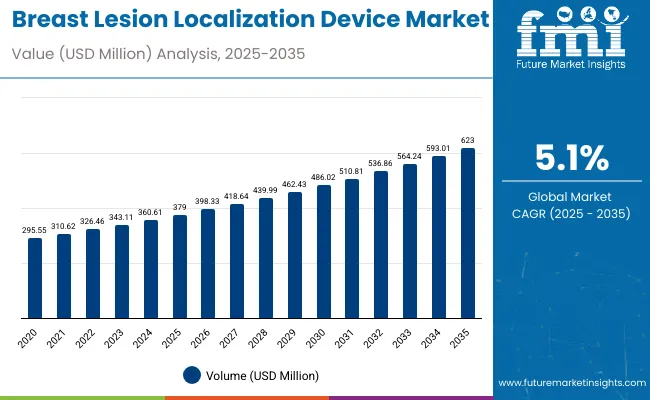
| Metric | Value |
|---|---|
| Estimated Size (2025E) | USD 379 million |
| Projected Value (2035F) | USD 623 million |
| CAGR (2025 to 2035) | 5.1% |
The market evolution is expected to be shaped by technological advancements in localization devices, growing awareness of early breast cancer detection, and the adoption of precision-guided surgical interventions.
By 2030, the market is projected to reach USD 487.0 million, adding an incremental opportunity of USD 108.0 million in the first half of the decade. The latter half (2030 to 2035) is projected to add USD 136.0 million, supported by the introduction of non-wire localization techniques, improved imaging-guided biopsy procedures, and increasing hospital investments in advanced diagnostic tools.
Companies such as Merit Medical Systems, BD, Argon Medical, Hologic, Endomagnetics Ltd., MatekMedikal, Sirius Medical Systems B.V., IZI Medical Products, MOLLI Surgical Inc., Elucent Medical, Intramedical Imaging, IsoAid, VigeoSrl, Medax Medical Devices, MDL Srl, BPB Medica, SterylabSrl, Tsunami Medical Srl, Laurane® Medical LLC, and Biomedical Srl are strengthening their market presencethrough product innovation, strategic collaborations, and regional expansions. Key trends shaping the market include minimally invasive technologies, regulatory compliance, and adoption of patient-friendly procedures.
The market holds a strong position across its parent industries, reflecting its rising adoption in healthcare, diagnostic imaging, and surgical sectors. Within healthcare, breast lesion localization devices account for about 62% of consumption, driven by the increasing incidence of breast cancer, expanding screening programs, and preference for minimally invasive diagnostic procedures.
In diagnostic imaging, they represent nearly 25% share, primarily used for precise tumor localization and guidance during biopsies and surgical interventions. In surgical applications, their combined contribution is estimated at 13%, fueled by adoption in lumpectomy and other targeted excision procedures. Overall, breast lesion localization devices play a critical role in ensuring procedural accuracy, patient safety, and operational efficiency.
The market is being driven by growing demand for early breast cancer detection, advancements in wire and non-wire localization techniques, and the adoption of image-guided biopsy procedures. Rising awareness of minimally invasive and patient-friendly procedures is further boosting adoption. Innovations include magnetic seed localization, radar-based systems, and non-radioactive marker technologies, aligning with trends in precision medicine and regulatory compliance.
Developments include expansion of manufacturing capabilities in North America, Europe, and Asia-Pacific to meet growing demand from hospitals, diagnostic centers, and emerging markets. Trends indicate a gradual shift toward non-wire, reusable, and high-precision localization devices, though wire localization remains dominant due to its proven efficacy, simplicity, and cost-effectiveness. Increasing regulatory emphasis on patient safety, procedural accuracy, and device performance is shaping R&D strategies and influencing global competition among leading manufacturers
Breast lesion localization devices’ unique ability to enable precise, minimally invasive tumor detection and biopsy guidance across healthcare and surgical settings is driving their adoption. Their accuracy, safety, and patient-friendly design make them indispensable in diagnostic imaging, surgical oncology, and hospital procedures, where early detection and procedural precision are critical.
Rising demand in the healthcare sector, particularly for breast cancer screening and minimally invasive biopsies, is a key growth driver. Growth is further supported by increasing adoption of advanced localization techniques, such as wire, magnetic seed, and radar-based systems, which improve procedural accuracy, patient comfort, and surgical outcomes. Innovations in non-wire, high-precision, and reusable localization devices are enhancing performance while aligning with regulatory standards and clinical best practices.
Increasing healthcare infrastructure investment in Asia-Pacific, along with stringent regulatory emphasis on patient safety, procedural accuracy, and device performance in North America and Europe, are strengthening market prospects. As hospitals and diagnostic centers prioritize early detection, procedural efficiency, and cost-effective solutions, breast lesion localization devices continue to gain traction. With leading manufacturers focusing on technological innovations, capacity expansions, and strategic partnerships, the market is expected to witness steady and long-term growth across its parent industries.
The market is segmented by technique, application, end user, and region. By technique, the market is categorized into wire localization, non-wire localization, radar reflector localization, magnetic seed localization, RFID tag localization, and radioisotope localization. Based on application, the market is bifurcated into breast biopsy and breast lumpectomy. In terms of end user, the market is divided into hospitals, ambulatory surgical centres, and specialty clinics. Regionally, the market spans North America, Latin America, Europe, East Asia, South Asia, Oceania, and the Middle East & Africa (MEA).
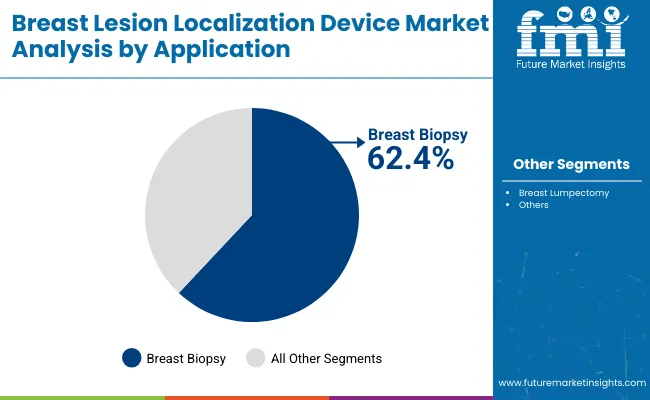
The breast biopsy segment is projected to dominate the application category with a 62.4% market share, driven by high adoption of localization devices in diagnostic imaging and minimally invasive procedures. These devices form the backbone of accurate tumor detection and biopsy guidance, where precision, safety, and procedural efficiency are critical.
Breast lesion localization devices are widely used to guide biopsy needles and surgical instruments, ensuring accurate tissue sampling, minimal invasiveness, and improved patient outcomes. The rising demand for early breast cancer detection in both developed and emerging markets has positioned this segment as the primary growth driver.
Increasing healthcare infrastructure, particularly in North America, Europe, and Asia-Pacific, coupled with stringent regulatory standards for patient safety and procedural accuracy, is further strengthening demand. Manufacturers are focusing on high-precision, patient-friendly, and regulatory-compliant localization solutions to meet hospital, surgical centre, and specialty clinic requirements. With expanding applications in biopsy procedures, the breast biopsy segment is expected to remain the cornerstone of application-based consumption in the coming decade.
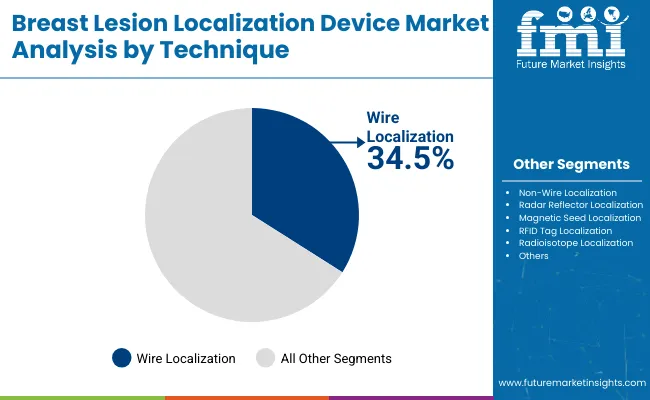
The wire localization segment is projected to dominate the technique category with a 34.5% market share, supported by its widespread adoption as a proven, cost-effective, and reliable method for tumor localization. Its functional properties, including simplicity, compatibility with imaging modalities, and clinical familiarity, make it indispensable for large-scale diagnostic and surgical use.
Wire localization devices are extensively used to guide biopsies and lumpectomies, owing to their ability to ensure accurate targeting, reduce procedural errors, and improve patient outcomes. The rising demand for minimally invasive and precise breast cancer interventions in both developed and emerging markets has positioned this segment as the primary growth driver.
Increasing investments in advanced wire-based localization technologies, coupled with expanding availability in hospitals, ambulatory surgical centres, and specialty clinics across North America, Europe, and Asia-Pacific, are further strengthening demand. Manufacturers are focusing on innovative, precise, and patient-safe solutions to meet stringent clinical and regulatory standards. With growing adoption in biopsy and surgical procedures, the wire localization segment is expected to remain the cornerstone of technique-based consumption in the coming decade.
In 2025, the global breast lesion localization device market is estimated at USD 379.0 million, with North America and Europe accounting for nearly 50-55% of total consumption. Applications include breast biopsy, lumpectomy, and other minimally invasive procedures across hospitals, ambulatory surgical centres, and specialty clinics.
Manufacturers are focusing on wire, non-wire, magnetic seed, radar reflector, RFID tag, and radioisotope localization technologies to meet clinical accuracy, patient safety, and regulatory compliance. Precision, procedural efficiency, minimally invasive design, and compatibility with imaging systems continue to support market penetration. Advanced and patient-friendly devices are increasingly being deployed in early cancer detection programs, further driving adoption.
Growing Healthcare and Diagnostic Demand Drives Market Adoption
The healthcare sector is the largest consumer of breast lesion localization devices, leveraging their accuracy, safety, and ability to guide minimally invasive procedures. With global breast cancer incidence rising and screening programs expanding, localization devices are witnessing increased demand. Wire localization and breast biopsy applications, in particular, account for a significant share due to their clinical reliability, ease of use, and procedural efficiency. The ability of these devices to ensure precise tumor targeting, reduce procedural errors, and improve patient outcomes continues to anchor their adoption. Expanding hospitals, surgical centres, and specialty clinics in North America, Europe, and Asia-Pacific further strengthen growth prospects.
Regulatory and Technical Factors Restrain Expansion
Market growth faces limitations due to stringent regulatory standards for patient safety, procedural accuracy, and device performance. Compliance with clinical validation, labeling, and safety protocols requires additional investment in R&D and quality control. Moreover, the high cost of advanced localization technologies and reliance on specialized manufacturing processes present supply chain and adoption challenges, particularly in emerging markets. These restraints are encouraging manufacturers to develop cost-effective, innovative, and regulatory-compliant solutions while balancing precision, reliability, and procedural efficiency.
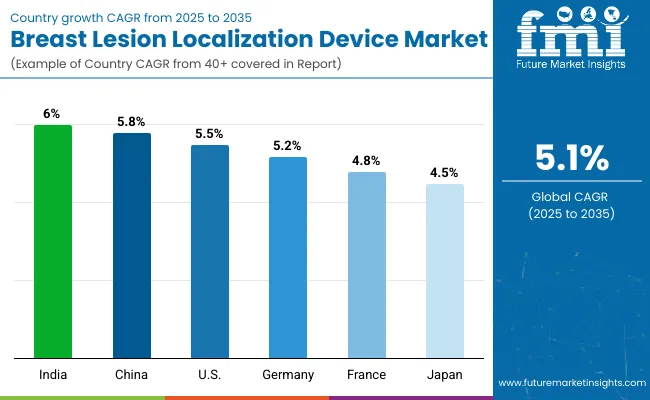
| Countries | CAGR (2025 to 2035) |
|---|---|
| India | 6.0% |
| China | 5.8% |
| USA | 5.5% |
| Germany | 5.2% |
| France | 4.8% |
| Japan | 4.5% |
The breast lesion localization device market shows varied growth trajectories across the top six countries. India leads with the highest projected CAGR of 6.0% from 2025 to 2035, supported by expanding healthcare infrastructure, growing breast cancer awareness, and increasing adoption of minimally invasive diagnostic procedures. China maintains strong growth at 5.8%, fueled by rising breast cancer screening programs, hospital expansions, and investment in advanced localization technologies. The USA follows at 5.5%, driven by well-established healthcare systems, stringent regulatory standards, and high adoption of wire and non-wire localization techniques. Meanwhile, Germany (5.2%), France (4.8%), and Japan (4.5%) experience steady growth, reflecting mature healthcare markets, regulatory emphasis on patient safety and procedural accuracy, and growing adoption of advanced, high-precision localization devices.
The report covers an in-depth analysis of 40+ countries; six top-performing markets are highlighted below.
The breast lesion localization device market in India is projected to expand at a CAGR of 6.0% from 2025 to 2035, fueled by increasing breast cancer awareness, expanding healthcare infrastructure, and growing adoption of minimally invasive diagnostic procedures. Hospitals, diagnostic centers, and specialty clinics are investing in wire and non-wire localization technologies to improve biopsy and lumpectomy accuracy.
Key Statistics:
Revenue from breast lesion localization devices in China is projected to grow at a CAGR of 5.8% from 2025 to 2035, driven by rising breast cancer screening programs, hospital expansions, and investment in advanced localization technologies. Manufacturers are focusing on magnetic seed, radar reflector, and non-wire systems to meet clinical accuracy standards and growing procedural demand.
Key Statistics:
Sales of breast lesion localization devices in the USA are expected to grow at a CAGR of 5.5% from 2025 to 2035, supported by advanced healthcare infrastructure, stringent FDA regulations, and high adoption of wire and non-wire localization techniques. Growth is driven by hospitals, ambulatory surgical centers, and specialty clinics, along with increasing breast cancer screening initiatives.
Key Statistics:
The breast lesion localization device market in Germany is projected to expand at a CAGR of 5.2% from 2025 to 2035, driven by well-established healthcare infrastructure, regulatory standards, and adoption of high-precision devices. Hospitals and specialty clinics focus on wire, magnetic seed, and radar reflector localization techniques to improve procedural accuracy and patient safety.
Key Statistics:
Revenue from breast lesion localization devices in France is projected to grow at a CAGR of 4.8% from 2025 to 2035, supported by expanding hospital infrastructure, cancer screening programs, and adoption of advanced localization techniques. Manufacturers emphasize regulatory-compliant, precise, and patient-friendly devices.
Key Statistics:
Demand for breast lesion localization devices in Japan is projected to grow at a CAGR of 4.5% from 2025 to 2035, supported by increasing breast cancer awareness, hospital expansions, and adoption of advanced imaging technologies. Manufacturers focus on high-precision, regulatory-compliant, and patient-friendly localization systems to meet strict clinical standards.
Key Statistics:
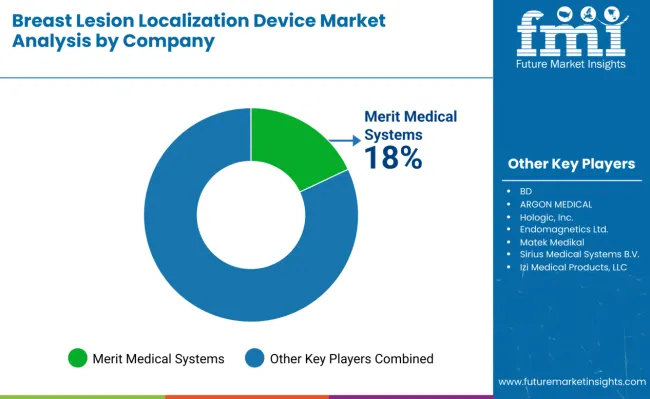
The market is moderately consolidated, comprising multinational medical device corporations, regional producers, and specialized localization system manufacturers. Key players include Merit Medical Systems, BD, ARGON MEDICAL, Hologic, Inc., Endomagnetics Ltd., MatekMedikal, Sirius Medical Systems B.V., Izi Medical Products, LLC, Molli Surgical Inc., Elucent Medical, Intramedical Imaging, Isoaid, VigeoSrl, MedaxMedical Devices, MDL SRL, BPB Medica, Sterylab S.R.L., Tsunami Medical Srl, and Laurane® Medical LLC. These companies leverage advanced manufacturing technologies, extensive R&D capabilities, and wide distribution networks to serve applications across hospitals, ambulatory surgical centers, and specialty clinics.
The market is characterized by a significant share for wire localization, accounting for over 34% of technique-based adoption in 2025. Wire and non-wire localization systems are preferreddue to their procedural accuracy, clinical reliability, and compatibility with imaging modalities. Magnetic seed, radar reflector, and RFID-based localization devices are increasingly adopted for minimally invasive surgeries, early-stage tumor detection, and improved patient outcomes.
Strategic initiatives such as mergers and acquisitions, joint ventures, regional expansions, and product innovation are common among market participants aiming to strengthen their global footprint. Additionally, companies are investing in high-precision, patient-friendly, and regulatory-compliant localization devices to meet evolving clinical standards and safety requirements. Overall, the breast lesion localization device market continues to evolve as established and emerging players focus on technological innovation, procedural accuracy, and expansion into high-growth healthcare and diagnostic segments, shaping the competitive landscape.
| Items | Values |
|---|---|
| Quantitative Units (2025) | USD 379 million |
| Technique | Wire Localization, Non-Wire Localization, Radar Reflector Localization, Magnetic Seed Localization, RFID Tag Localization, and Radioisotope Localization |
| Application | Breast Biopsy and Breast Lumpectomy |
| End User | Hospitals, Ambulatory Surgical Centres , and Specialty Clinics |
| Regions Covered | North America, Latin America, Western Europe, Eastern Europe, South Asia and Pacific, East Asia, and Middle East & Africa |
| Country Covered | United States, Canada, Unite d Kingdom, Germany, France, China, Japan, South Korea, Brazil, Australia and 40+ countries |
| Key Companies Profiled | Merit Medical Systems, BD, ARGON MEDICAL, Hologic, Inc., Endomagnetics Ltd., Matek Medikal , Sirius Medical Systems B.V., Izi Medical Products , LLC, Molli Surgical Inc , Elucent Medical, Intramedical Imaging, Isoaid , Vigeo Srl , Medax Medical Devices, MDL SRL, BPB Medica , Sterylab S.R.L., Tsunami Medical Srl , Laurane ® Medical LLC, and Biomedical Srl |
| Additional Attributes | Dollar sales by technique , application, and end user, regional demand trends, competitive landscape, adoption across hospitals, ambulatory centers, and specialty clinics, integration with high-precision, patient-friendly, and regulatory-compliant solutions, innovations in wire and non-wire localization devices, procedural accuracy and safety standards across hospitals and surgical centers |
In terms of technique, the industry is divided into wire localization, non-wire localization, radar reflector localization, magnetic seed localization, RFID tag localization and radioisotope localization.
In terms of application, the industry is segregated into breast biopsy and breast lumpectomy.
The industry is classified by end user as hospitals, ambulatory surgical centres and specialty clinics.
Key countries of North America, Latin America, East Asia, South Asia, Western Europe, Eastern Europe and Middle East and Africa (MEA) have been covered in the report.
The global breast lesion localization device market is estimated to be valued at USD 379.0 million in 2025.
The market size for breast lesion localization device is projected to reach USD 623.0 million by 2035.
The breast lesion localization device market is expected to grow at a 5.1% CAGR between 2025 and 2035.
The wire localization segment is projected to lead in the breast lesion localization device market with 34.5% market share in 2025.
In terms of application, the breast biopsy segment is projected to command 62.4% share in the breast lesion localization device market in 2025.






Full Research Suite comprises of:
Market outlook & trends analysis
Interviews & case studies
Strategic recommendations
Vendor profiles & capabilities analysis
5-year forecasts
8 regions and 60+ country-level data splits
Market segment data splits
12 months of continuous data updates
DELIVERED AS:
PDF EXCEL ONLINE
Breast Reconstruction Meshes Market Size and Share Forecast Outlook 2025 to 2035
Breast MRI Screening Market Size and Share Forecast Outlook 2025 to 2035
Breast Density Assessment Software Market Size and Share Forecast Outlook 2025 to 2035
Breast Cancer Grading Tools Market Size and Share Forecast Outlook 2025 to 2035
Breast Cancer Screening Tests Market Size and Share Forecast Outlook 2025 to 2035
Breast Cancer Diagnostics Market Size and Share Forecast Outlook 2025 to 2035
Breast Biopsy Market Size and Share Forecast Outlook 2025 to 2035
Breastfeeding Accessories Market Size and Share Forecast Outlook 2025 to 2035
Breast Reconstruction Surgery Market Analysis - Size, Share, and Forecast 2025 to 2035
Breast Pump Market – Trends & Forecast 2025 to 2035
Breast Fillers Market Analysis - Trends & Forecast 2025 to 2035
The Breast Cancer Drug Market is segmented by Drug Class, and Distribution Channel from 2025 to 2035
Industry Share & Competitive Positioning in Breast Implants Market
Industry Share & Competitive Positioning in Breast Reconstruction Surgery Market
Breast Imaging Market Analysis - Size, Share & Growth Forecast 2024 to 2034
Breast Biopsy Devices Market Analysis - Innovations & Forecast 2025 to 2035
Breast Localization System Market
Breast Lesion Localization Market Size and Share Forecast Outlook 2025 to 2035
Smart Breast Imaging Market Analysis - Size, Share, and Forecast Outlook 2025 to 2035
Breast & Prostate Cancer Diagnostics Market in Europe – Trends & Forecast 2025 to 2035

Thank you!
You will receive an email from our Business Development Manager. Please be sure to check your SPAM/JUNK folder too.
Chat With
MaRIA